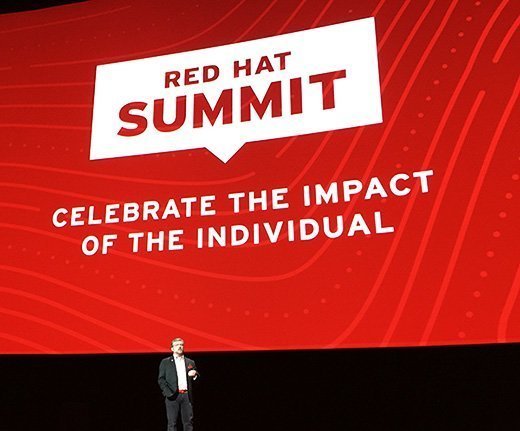Open source philosophy goes well beyond software -- and into our lives
According to advocates, open source software is just the first step in a larger movement -- one that aims to make open source an integral part of our daily lives.
The free and open software movement has found considerable mind share among today's enterprise organizations. But proponents of the open source philosophy will not stop at the business level -- they are finding new ways to apply the ideas behind open source to almost every aspect of people's lives.
The final day of the 2017 Red Hat Summit featured keynote speakers and panels that hit upon three key areas where Open Source is affecting not just software development communities, but also hardware, agriculture and culture surrounding corporate software teams.
The font of innovation, beyond the enterprise
Tim Yeaton, executive vice president of corporate marketing at Red Hat, opened the day's keynote speeches by touting open source communities as the center of change for not just software, but technology innovation in general.
"Most innovation is happening in upstream, open source communities," he said. "That model of collaboration has scaled beyond software … it's the font of innovation for technology."

One of these areas of innovation is hardware. Alicia Gibb, executive director for the Open Source Hardware Association, based in Boulder, Colo., talked about advancements that have been made in the open source hardware community, highlighting examples such as the OpenPCR thermocycler, a piece of equipment capable of detecting and sequencing DNA.
She also mentioned Arduino, an open source electronics platform based on easy-to-use hardware and software and intended for anyone making interactive projects, which includes drones, fingerprint scanners and even a robotic dancing teapot. Arduino was also the base of NASA's OpenCuriosity, an open source ExoMars rover, and the Safecast Geiger Counter, which was used in Japan following the Fukushima disaster.
"We have everything from open source tractors to open source fashion," Gibb said, adding that the possibilities combining the internet of things and open source are very promising.
Caleb Harper, principal investigator and director of the Open Agriculture Initiative (OpenAG) at the MIT Media Lab, showcased another application of the open source philosophy that is growing out from the software world. Harper introduced audience members to the idea of applying the ideas of open source to the agriculture industry in order to stabilize the world's food supplies.
Harper explained how OpenAG is using open source to create what he called "climate democracy." By processing and applying data about climate, plant biology, agricultural techniques and other factors that directly affect the growth of food, precise conditions can be replicated in controlled environments to grow food not native to that region or, in some cases, ancient fruit that had once been extinct, such as a type of tomato that had not been eaten in 150 years. In one anecdote, he explained how this initiative allowed Syrians in a refugee camp to replicate the conditions needed to grow food native to their home.
"Can we not take data and apply it to what we eat?" Harper asked, adding that part of OpenAG's goal is to get to a point where data can be shipped instead of food.
The data OpenAG collects and shares can also be used toward more efficient and economical growth practices that can, for example, reduce water consumption and increase speed of growth.

One software professional who attended the show, Tony Heron, said he never really thought much about applying the open source philosophy beyond software before listening to the Red Hat keynotes.
"I thought the keynotes on open hardware and open agriculture were kind of mind-blowing," said Heron, who is a system administrator at the Canadian direct bank Tangerine. "I never thought of putting open source past the software side … the possibilities for humanity in general with what was documented was pretty fantastic."
Another attendee, Robbert Rijkse, shared the sentiment that open source has a place beyond the software world. Rijkse, who is team lead of technical services at Tangerine, said organizations should make an effort to apply open source to the top of their software stacks, including anything in the cloud, as well as beyond.
"I think the thing that Red Hat showed through all the keynotes is that open source should not just be applied to software," Rijkse said. "It should be applied to all aspects of not just IT, but [of] our lives."
Open source for cultural change
In addition to world-changing initiatives, the keynotes also highlighted how open source can function as what Dietmar Fauser, vice president of research and development quality assurance at Amadeus, based in Madrid, called a "cultural change agent."
"It's putting teams together and creating energy and common knowledge," Fauser said.
The importance of open source as a cultural change agent was supported by speaker Ashesh Badani, vice president of cloud and OpenShift BU at Red Hat, who said the efforts of organizations to move toward continuous delivery is, at its heart, a cultural problem.
"The real problem is cultural," he said. "Teams need to work together and be able to collaborate across channels."
Other speakers noted that open source is having a significant impact in terms of reducing the amount of time it takes software teams to achieve production goals. Chris Wright, vice president in the office of technology at Red Hat, noted that Red Hat's efforts with the managed cloud computing company Rackspace have helped software teams realize quicker workflows, reducing tasks that may have taken over a month to days, or even minutes.
"How can you create a production environment from scratch to functional?" Wright asked. "Without Agile, it can take months. Here, we are looking at seven to seven-and-a-half minutes."
Open source vs. proprietary
Open source is the future of IT and software development, Wright said in a discussion about the relation between open source and DevOps. Wright noted that the traditional method of working with proprietary enterprise software suppliers may soon go to the wayside, as organizations buy further into the open source philosophy.
"The future of IT is so much about collaboration," Wright said. "This is how we're building our next-gen infrastructure."
Rijkse agreed that he sees the developer mindset moving further and further away from wanting to use proprietary software, citing that open source simply makes it easier for his software team to achieve its goals. As such, he said he sees much more growth on the open source side than the proprietary side due to the demand from developers.
"We like to integrate a lot of products … it's a lot harder to do that with proprietary software," Rijkse said. "The APIs are not standard. The APIs change with every version; they're not well-documented. And if you needed to add a feature, it's very difficult to do unless you involve the vendor who provided that solution, which can get very expensive."
Heron added that the popularity of the Red Hat Summit, particularly among large software vendors, suggests to him that organizations are shifting away from strict proprietary software distribution practices in favor of an open source model. In fact, he said he thinks organizations that do not make the shift may be hurting the development community.
"If you look at the size of this conference and the huge players that are here, any of the old arguments of, 'You can't make money by giving this out for free,' have been shown to be malarkey," Heron said. "You don't need to keep it proprietary to make money, and you're just hurting innovation doing it that way."
Rijkse also added that open source tools allow his team to speed up development, and the fact it is open source saves them from having to create tools on their own.
"We're using things like jQuery, so we can speed up development," Rijkse said. "Why would we reinvent the wheel? JQuery's already there … it's got all the features we're looking for, so why are we trying to develop it ourselves?"
Lingering security concerns
Security still comes into question when enterprises explore open source options, such as those provided through Red Hat. However, using the Rackspace collaboration as an example, Wright stressed that Red Hat is "simplifying the private cloud and enabling open source innovation without sacrificing any of the stability, security or critical underlying infrastructure."
Heron admitted there is an argument to be made about the insecurity of open source, in that an individual who wants to do harm to an organization could, in theory, access the code behind applications that an organization is running. However, he said he believes this argument falls short, since those who want to do harm could, in fact, access a proprietary provider's code -- and an organization would not have any legal recourse to look at that code and address the code themselves and address the vulnerability.
"The truth of the matter is that the people who want to do harm are going to break the code to be able to look at the proprietary stuff if they want to anyway," Heron said. "And there's no legal way for an organization to do the same thing and see where those issues are. In that respect, there's a strength to open source."
But despite any debate concerning the risk or lack of risk in open source, Marco Bill-Peter, vice president of customer experience and engagement at Red Hat, encouraged attendees to consider the "benefits of being a risk-taker within reason," and using open source to solve business challenges.
"If government and financial institutions can do it, you can do it as well," he said, referencing the numerous government and financial intuitions highlighted as contestants for the Innovation Award, including Barclays and the government of the Jalisco, one of the 32 federal entities of Mexico. "Be bold."







